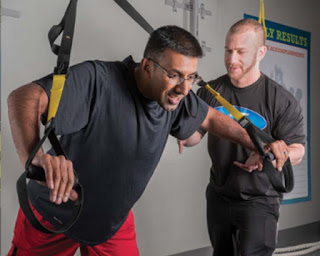Trainer
Tuesdays
Welcome back to the weekly edition on Trainer Tuesdays. Make sure to check in at our blog every Tuesday evening to learn the expertise of our great staff. Aside from being fantastic exercise coaches, they are also extremely knowledgeable in many aspects of health and fitness; so, it's time that you get to know them a little better! Each week, we will post a frequently asked, or sometimes just a fun fitness related question followed by the answers of each of the trainers at Fitness Together Brecksville.
Is it okay to exercise
with weights two days in a row?
Adam Teplitz: Weight training is a vital
part of every exercise program. However, one of the most
 |
| Fitness Together Personal Trainer Adam Teplitz with a client |
Whether you can efficiently weight train two days in a row depends on many factors, including what type of training you're doing, your goals and how fatigued you are.
One factor is muscle soreness. After an intense training session, you will often experience delayed onset muscle soreness, which can cause your muscles to feel tight and painful. This soreness is caused by the breakdown of muscle fibers during the lowering, or eccentric phase of an exercise. If you experience particularly bad DOMS after a training session, it may be best to take a day off.
Another factor is the routine that you're on. If you are following a full body program, you will need to leave at least a day of rest between sessions. This will give the muscles time to repair themselves. If however, you are following a split routine ( isolating certain muscle groups ), then there will you be times when you have to weight train two or more days in a row to meet the requirements of the routine.
One final factor is practice. Strength coach Dan John advises in his article , "The Gable Method", that if something is important , you should do it every day, and kettle bell trainer Pavel Tsatsouline bases his "grease the groove" training method around the idea that "specificity plus frequent practice equals success,". Both of these philosophies support the idea of performing certain exercises daily. If you have an exercise that you struggle with, you should aim to perform it every day. Use light weights and focus on using perfect technique, only taking a rest day when you have to. The key here is that daily practice is needed if you wish to improve.
 |
| Fitness Together personal trainer Steven Madden |
Steven Madden: Yes, you can workout with weights two days in a row,
as long as you are not Your muscles need time to recover, and
working them two days in a row is actually more harmful than good. But my schedule only allows me to work out on
two consecutive days. All you need to do
is make sure you are not working the same muscle groups. My current routine has me lifting four days a
week. I lift Monday, Tuesday, rest Wednesday
and lift Thursday and Friday. On Monday,
I do chest, and to make sure I don't overdo it, on Tuesday I work back. I have even done routines where I lifted six
days a week, but I never repeated the same groups two days in a row. By all means, lift as often as you can, just
rest the muscles after you do.
working out the same muscle groups.
Taylor Burns: You
can exercise two days in a row if you are using different muscle groups because
it gives the muscles time to recover while working out other muscles. So it
just depends on what kind of workout routine you are on. However, it's not
recommended to use the same muscles two days in a row because the muscles need
time to repair and grow from the day before.
©
2015 Fitness Together, Inc. All Rights Reserved. Powered by Fusionbox.
About | Contact | Franchise | Suppliers | History | Leadership | NutritionTogether |Sitemap | PrivacyPolicy | TermsofUse | Facebook | YouTube | Twitter | Linkedin



